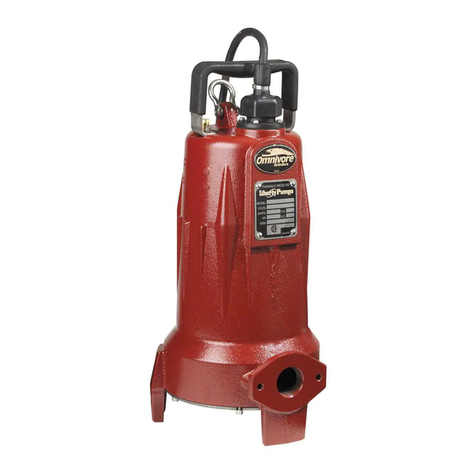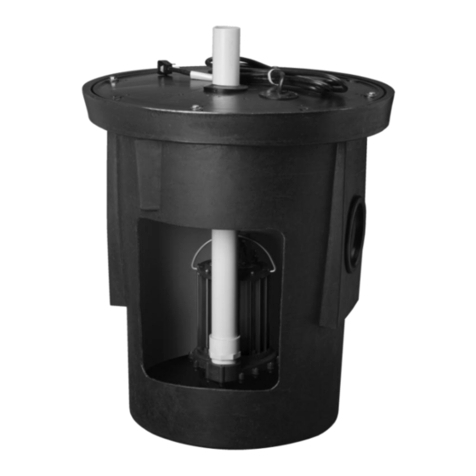
5651000K Copyright © Liberty Pumps, Inc. 2019
All rights reserved. 3 | EN
Safety Precautions
Accidental contact with electrically live parts, items, fluid, or
water can cause serious injury or death.
Always disconnect pump(s) from power source(s) before
handling or making any adjustments to either the pump(s),
the pump system, or the control panel.
All installation and maintenance of pumps, controls,
protection devices, and general wiring shall be done by
qualified personnel.
All electrical and safety practices shall be in accordance with
the National Electrical Code®, the Occupational Safety and
Health Administration, or applicable local codes and
ordinances.
Do not remove cord and strain relief, and do not connect
conduit to pump.
Pump shall be properly grounded using its supplied
grounding conductor. Do not bypass grounding wires or
remove ground prong from attachment plugs. Failure to
properly ground the pump system can cause all metal
portions of the pump and its surroundings to become
energized.
Do not handle or unplug the pump with wet hands, when
standing on damp surface, or in water unless wearing
Personal Protective Equipment.
Always wear dielectric rubber boots and other applicable
Personal Protective Equipment (PPE) when water is on the
floor and an energized pump system must be serviced, as
submerged electrical connections can energize the water. Do
not enter the water if the water level is higher than the PPE
protection or if the PPE is not watertight.
Do not lift or carry a pump or a float assembly by its power
cord. This will damage the power cord, and could expose the
electrically live wires inside the power cord.
The electrical power supply shall be located within the length
limitations of the pump power cord, and for below grade
installations it shall be at least 4 ft (1.22 m) above floor level.
Do not use this product in applications where human contact
with the pumped fluid is common (such as swimming pools,
fountains, marine areas, etc.).
Protect the power and control cords from the environment.
Unprotected power and control (switch) cords can allow
water to wick through ends into pump or switch housings,
causing surroundings to become energized.
Single-phase 208/230V pumps shall only be operated
without the float switch by using the circuit breaker or panel
disconnect.
Do not use an extension cord to power the product.
Extension cords can overload both the product and extension
cord supply wires. Overloaded wires will get very hot and can
catch on fire.
This product requires a separate, properly fused and
grounded branch circuit, sized for the voltage and amperage
requirements of the pump, as noted on the nameplate.
Overloaded branch circuit wires will get very hot and can
catch on fire. When used, electrical outlets shall be simplex of
the appropriate rating.
Do not use this product with or near flammable or explosive
fluids such as gasoline, fuel oil, kerosene, etc. If rotating
elements inside pump strike any foreign object, sparks may
occur. Sparks could ignite flammable liquids.
Sewage and effluent systems produce and may contain
flammable and explosive gases. Prevent introduction of
foreign objects into basin as sparks could ignite these gases.
Exercise caution using tools and do not use electronic devices
or have live, exposed electrical circuits in or around basins,
open covers and vents.
These pumps are not to be installed in locations classified as
hazardous in accordance with the National Electric Code®,
ANSI/NFPA 70.
Do not modify the pump/pump system in any way.
Modifications may affect seals, change the electrical loading
of the pump, or damage the pump and its components.
All pump/pump system installations shall be in compliance
with all applicable Federal, State, and Local codes and
ordinances.
Do not allow children to play with the pump system.
Do not allow any person who is unqualified to have contact
with this pump system. Any person who is unaware of the
dangers of this pump system, or has not read this manual,
can easily be injured by the pump system.
In 208/230V installations, one side of the line going to the
pump is always “hot”, whether the float switch is on or off. To
avoid hazards, install a double pole disconnect near the
pump installation.
Vent basin in accordance with local code. Proper venting of
sewer and effluent gases alleviates poisonous gas buildup
and reduces the risk of explosion and fire from these
flammable gases.
Wear adequate Personal Protective Equipment when working
on pumps or piping that have been exposed to wastewater.
Sump and sewage pumps often handle materials that can
transmit illness or disease upon contact with skin and other
tissues.
Do not enter a pump basin after it has been used. Sewage
and effluent can emit several gases that are poisonous.
Do not remove any tags or labels from the pump or its cord.
Keep clear of suction and discharge openings. To prevent
injury, never insert fingers into pump while it is connected to
a power source.
Do not use this product with flammable, explosive, or
corrosive fluids. Do not use in a flammable and/or explosive
atmosphere as serious injury or death could result.
This product contains chemicals known to the State of
California to cause cancer and birth defects or other
reproductive harm. www.p65warnings.ca.gov.
RISK OF ELECTRIC SHOCK
RISK OF FIRE
RISK OF SERIOUS INJURY OR DEATH

















































